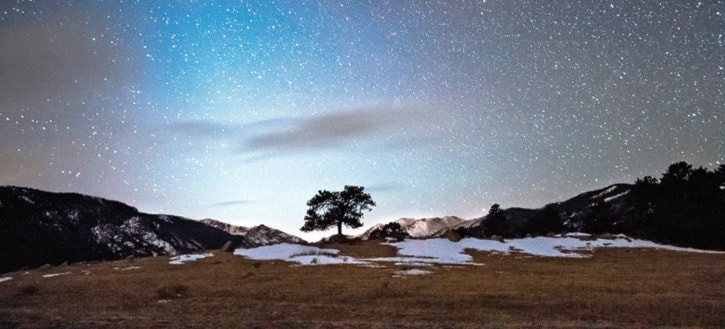I have good news and bad news.
The good news is February brings a meteor shower. The bad news is it’s only visible in the Southern Hemisphere.
This is the minor Alpha Centaurids meteor shower. Anyone visiting New Zealand, Australia, or South America can see it peak before dawn on Feb. 8 with up to six meteors an hour.
Those of us stuck in the Northern Hemisphere get to see a different phenomena in February: the Zodiacal Light.
This is a soft, cone-shaped glow that appears in the west just after twilight, starting Feb. 12. It’s caused by sunlight reflecting off dust particles that hover just above our atmosphere. The cone will line up with the ecliptic (the flat plane on which most planets circle the sun), so it will appear to lean to the side. Venus and Mars are good guides as well.
The Zodiacal Light is good for naked-eye observing, and night-time photographers with steady hands or a tripod. It shows up best when the moon or village lights aren’t sharing the sky.
The Planets
In February, Mercury will appear low in the southeast during the morning twilight. Because it doesn’t rise very far above the horizon, it will probably stay hidden for anyone surrounded by mountains. But if you happen to be on a boat in calm seas with a telescope, it will appear as a disk with a slice of shadow, like a partially full moon.
Venus is a hard planet to miss. It will reach its brightest the night of Feb. 16-17, and will stay that way all month. On Feb. 1 it will form a diagonal line with the crescent moon, sandwiching Mars between them in early evening. Venus rises high in the night sky, so combined with its brightness, it can actually cast shadows in a dark-enough sky. I suggest you try to see this rare effect after February’s full moon has passed. I doubt we’ll have a fresh blanket of snow to make the shadows easier to see, but you can try a white sheet — just don’t let your mother catch you using her good clean sheets.
This is also a great time to see Venus through a telescope, both because of its size and because its phases. Like our moon’s phases, it changes quickly. On Feb. 1 it will appear to have a large, lit crescent that you should be able to see with steady binoculars, though the crescent will shrink throughout the month.
Mars starts the month sandwiched between Venus and the crescent moon in the west-southwest sky at about 7 p.m. it will follow Venus this month by starting in the west and slowly drifting northeast. On Feb. 25 - 27, look to Mars with good binoculars (7 x 50) or a low-powered telescope and you should see orange-red Mars above the blue-green ball that is Uranus.
Jupiter rises by 11:30 p.m. on Feb. 1, and two hours earlier by month’s end. Although it is clear of the horizon by midnight, wait a couple hours before twilight begins to get the best views through a telescope. Even the smallest telescope will show you the planet’s two dark bands and the lighter band that separates them. The larger the telescope, the better you will see the Great Red Spot. This Earth-sized storm appears more orange than red and becomes obvious when its side faces us directly. If you don’t see it be patient — Jupiter’s day is only 10 hours long.
If you see a dark circle passing over Jupiter’s disk, don’t panic. It is not a flying saucer, but the shadow of one of the planet’s moons and will be followed shortly by the moon itself. Jupiter’s four largest moons are, in order of largest to smallest: Ganymede, Callisto, Io and Europa. Jupiter will appear largest the night of Feb. 16-17.
Saturn doesn’t rise above the southeastern horizon until shortly after 4 a.m. in early February, thought it will rise earlier each day until it is rising at 2:30 a.m. at the end of the month. The best viewing is at about an hour before twilight and any telescope should allow you to see the rings. Even small telescopes will be able to see Saturn’s moon Titan.
Uranus is hard to find in the southwestern evening sky. It is easier to find in late February when Mars is nearby, but to find it the rest of the month can be a challenge. The best directions I can give you is to look east of the constellation of Pegasus. You will need binoculars.
Neptune is one planet you’ll have to hunt for with binoculars or a telescope. It appears during the first week of the month just after sunset, low in the west-southwest. It will descend into the sunset after this first week and out of sight until it returns to view before dawn in April.
Other events
Again, if you happen to be in South America or Africa on Feb. 26, you might witness an annular solar eclipse — the moon will pass in front of the sun, but won’t cover it completely, leaving a circle of sunlight around the moon. The track of the eclipse will start in the South Pacific, crossing over the Andes and high plateaus of Patagonia before reaching the coast of Angola and ending at sunset in the Democratic Republic of Congo.
In other news, this fall the National Oceanic and Atmospheric Administration’s (NOAA) Space Weather Prediction Center starting forecasting the effects of solar storms to protect power and communications grids. The forecasts may also help in trying to predict when the Northern Lights will appear. Check it out at http://www.swpc.noaa.gov/
